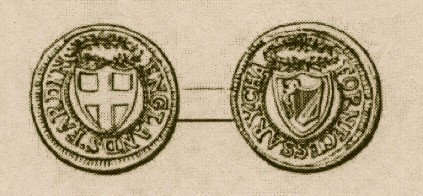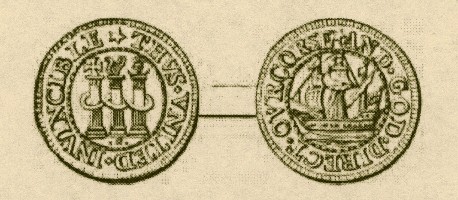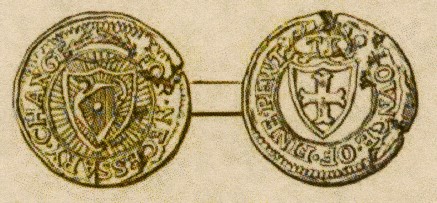

The above two pieces are of copper, but are sometimes found of two metals, copper and brass, and in the
National Collection is a copper specimen of No. 2 with a very large brass centre.
The words on both obverse and reverse are sometimes separated by small lozenges but more generally by small dots.
This occurs most frequently in mixed metal; sometimes, but very rarely, in pure copper. I have specimens reading
FARDIN and CHA in brass, brass with a copper centre, and copper with a brass
centre. I have also one reading FARTHING and CHANGE in brass with a copper centre,
and one reading FARTHING and CHANG in copper. Pewter specimens in the cabinet
of Mr. R. A. Hoblyn (one from the Neligan Sale) are apparently forgeries. A rare variety exists with the letter
K in the centre of the wreath on both sides. It occurred in the Devonshire Collection and elsewhere,
and is of brass with a copper stud in the centre. There is one also in the National Collection and in my own,
of a yellowish metal, on which the K also makes its appearance. My example (ex Bergne and
Brice Colls.) reads FARTHING and CHAN. The specimens which I have seen, of the
ordinary type, differ materially in size and thickness, and are from several different dies. With regard to the
letter K on the variety mentioned I have nothing to suggest, except that there may be some
connection between this and the T. K. on the pewter pattern, No. 7, afterwards described.
This appears to have been struck from the die of the so-called Ramage sixpence, but the edge is not inscribed.
It is of copper, as is also the next.
Some specimens occur without the R (the initial apparently of Rawlins) under the pillars on the
obverse. I have one of these struck upon a flan composed of a copper centre enclosed in a ring of bell-metal,
around which is an outer band of copper. (Marsham Sale, Lot 702.)
I have not seen the above. It is presumably a private token.
There is a variety with the sun's rays wanting.
This token was issued in 1654 (vide Numismatic Journal, vol. ii., p. 274), and that it is most probably
a private token is evidenced by the following extract from the "Mercurius Politicus" for May, 1654. It is headed
"ADVERTISEMENT."
"Whereas several persons have presented unto his Highness and Council divers patterns for the making of a
common farthing for the use of the Commonwealth, and have attended several times about the same, and at this
day the business is depending before his honorable Councel and their pleasure as yet not signified therein;
and yet, notwithstanding, in the meantime several persons have presumed without any authority or declaration of the
State to set the Commonwealth of England's arms on a piece of pewter of the weight of a quarter of an ounce, and
have procured intimation in print to be made that these pewter farthings are allowed to pass current through the
Commonwealth of England, &c., and in pursuance thereof have and do daily vend these unauthorized pewter farthings
in London and other parts of this Commonwealth to the great deceit and dammage of this nation. These are to
give notice to all men, that if there be not a sudden stop to the making and vending of those pewter farthings
the Commonwealth will be greatly deceived, both by the mixing the pewter with lead, and also every tinker
and other lewd persons will get molds and make the said pewter farthings in every corner. Therefore all people
ought to take notice that no farthings are to pass but such only as shall be authorized by his Highness and
his Councel to pass through the Commonwealth." (May 4 to 11.) This advertisement, the wording of which is
very peculiar, undoubtely proceeded from some of those parties who had patterns already before the Protector and
his Council for consideration. The next two pieces described, examples of the first of which, so far as I
know, only exist in the National Collection and in my own, are also probably private tokens:
In the Museum specimen the obverse of the coin is of brass, and the reverse of copper. It was purchased
at the Trattle Sale (Lot 1522).
This is also in the National Collection (from the Trattle Sale, Lot 1521), and has also a brass obverse and
copper reverse. T. K. and E. R. were most probably the initials of the names
of the issuers of the lastly described three pieces.
In my collection (lately in that of Mr. W. Brice) is a pewter piece half as large again as any of those above
described, which has all the appearance of being a contemporaneous coin. Its weight is 116 grains.
I have not seen this elsewhere, and it is probably unique.
In my Collection and in that of Mr. Hoblyn exists a pewter piece of the same period, on the obverse of which is the
St. Georges's Cross in a shield within a wreathed border, and on the reverse two shields bearing St. George's
Cross and the Irish harp respectively. The date above, 1649. In the Hunter Collection is a
similar piece (see Combe's note to Vertue's work on Thomas Simon's Medals, Coins, &c.). On another
similar piece in my cabinet the date is somewhat indistinct, but appears to be 1654.
The Copper, Tin, and Broze Coinage of England
H Montagu, F.S.A, , 1893
Commonwealth
The Commonwealth, 1648-1660
During the period of the Commonwealth many patterns for copper coins were struck, but from the extreme rarity
even of those which most frequently occur, it does not appear that any were actually put into circulation. They
present no great variety of type.
1. O. FARTHING. TOKENS. OF. ENGLAND. The words divided by lozenges. A shield with the cross
of St. George. m. m. a mullet.
R. FOR. NECESSITY. OF. CHANGE. 1649. Words divided as before. A shield with the
Irish harp. m. m. a mullet (Snelling, Copp. Coins, Pl. 6, No. 2). R. 6.
2. O. THE. FARTHING. TOKENS. FOR. Words divided by mullets. Shield with St. George's Cross. m. m.
a mullet.
R. THE. RELEFE. OF. THE. PORE. Words divided as before. A shield with the
Irish harp. (Snelling, Copp. Coins, Pl. 6, No. 3.) R. 6.
3. O. ENGLANDS. FARDIN. and sometimes FARDING., FARTHING. or FARTHINGS.
A shield with St. George's cross, surmounted by a garland.
R. FOR. NECESSARY. CHANGE., sometimes CHANG., CHAN. or CHA.
A shield with the Irish harp, similarly surmounted with a garland. (Snelling, Copp. Coins, Pl. 6, No. 4.) R. 4.

4. O. TRVTH. AND. PEACE. The words separated by mullets. A shield with the cross of St. George.
R. TRVTH. AND. PEACE., Mullets between the words. A shield with the Irish
harp. (Snelling, Copp. Coins, Pl. 6, No. 6.) R. 6.
5. O. THVS. VNITED. INVINCIBLE. m. m. a mullet. The words separated by lozenges. Three pillars
linked together, bearing respectively a cross, a harp and a thistle; under the pillars the letter R.
R. AND. GOD. DIRECT. OVR. COVRSE., COVRS. or CORSE. m. m. a
mullet. The words separated as before. A ship in full sail.) R. 6.

6. O. GOD. IS. OVR. SVN. AND. SHIELD. A scroll-shaped shield bearing a sun; the whole within an
inner circle. m. m. a mullet.
R. OVR. FOVNDATION. IS. A. ROCKE. A rock beaten by the waves, within an inner circle;
over the rock within a partial second circle, A. TOKENE., 1651. m. m. mullet. R. 8.
7. O. ¼ OVNCE. OF. FINE. PEWTR. A shield with a cross fourchée. Above it a garland
containing the letters T. K.
R. FOR. NECESSARY. CHANGE. A shield with the Irish harp; above it, a garland.
From the centre of the shield, a sun with rays extending through the shield to the inner circle. R. 5.

8. O. THE-COMONS-PETICION. in three lines. Underneath, a harp and a shield bearing
St. George's Cross, placed side by side between two cinquefoils. A cinquefoil also on each side of
"THE."
R. THE-POORES-RELEFE. in three lines. A cinquefoil on each side of
THE. and a harp and shield similar to those on the obverse, but between the letters
E. R. R. 8.
9. O. SVCH-GOD-LOVES. in three lines; GOD. between a harp and a shield.
Underneath, E. R. between two cinquefoils.
R. PITTY-THE-POORE. in three lines. Underneath, 1652.
Obverse and reverse within a beaded circle. R. 6.
10. O. THE. FARTHING. TOKEN. OF. THE. Harp in shield; small diamonds between the words. m. m.
a mullet.
R. COMMONWEALTH. OF. ENGLAND. St. George's cross in shield. Words
divided as before. m. m. a mullet. R. 8.